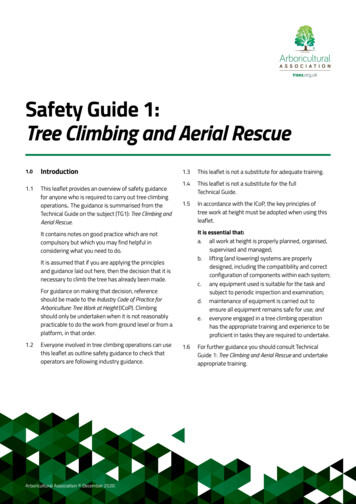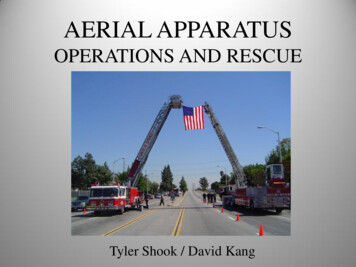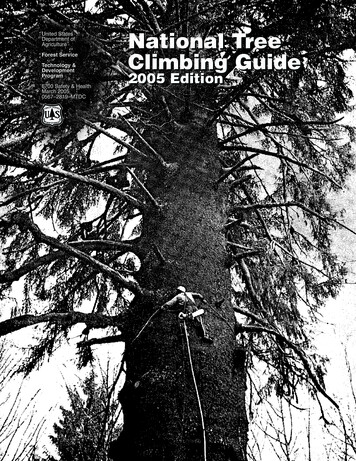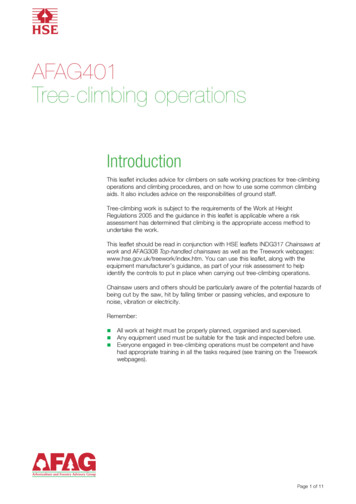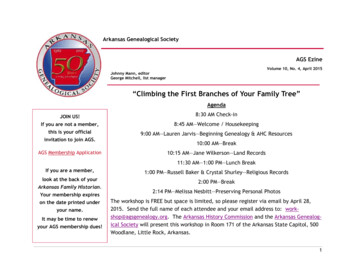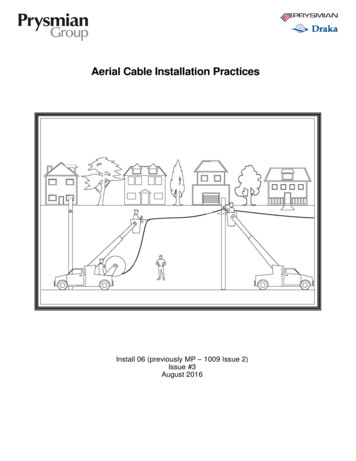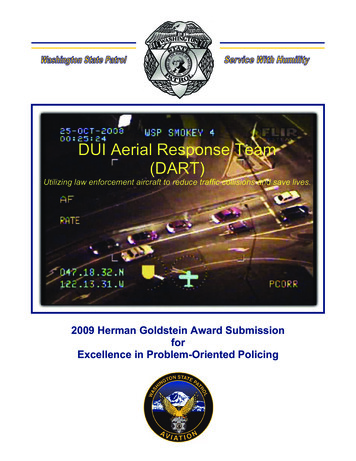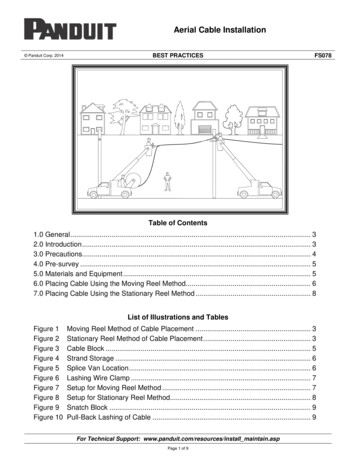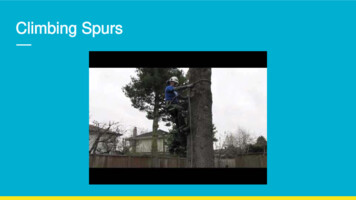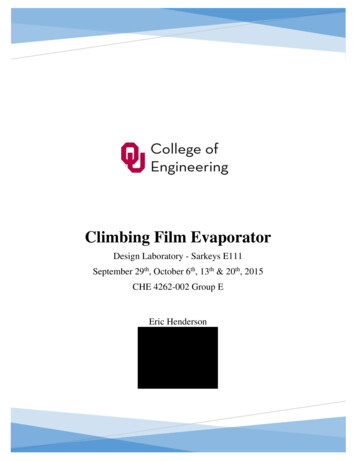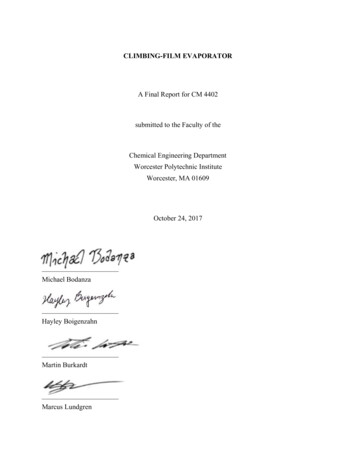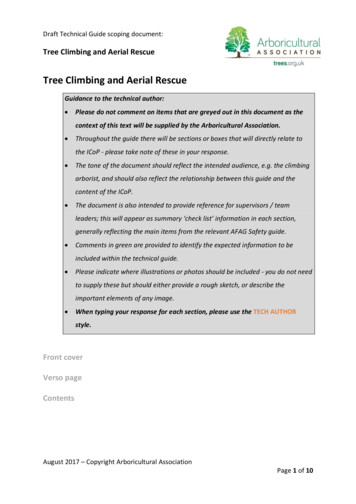
Transcription
Draft Technical Guide scoping document:Tree Climbing and Aerial RescueTree Climbing and Aerial RescueGuidance to the technical author: Please do not comment on items that are greyed out in this document as thecontext of this text will be supplied by the Arboricultural Association. Throughout the guide there will be sections or boxes that will directly relate tothe ICoP - please take note of these in your response. The tone of the document should reflect the intended audience, e.g. the climbingarborist, and should also reflect the relationship between this guide and thecontent of the ICoP. The document is also intended to provide reference for supervisors / teamleaders; this will appear as summary ‘check list’ information in each section,generally reflecting the main items from the relevant AFAG Safety guide. Comments in green are provided to identify the expected information to beincluded within the technical guide. Please indicate where illustrations or photos should be included - you do not needto supply these but should either provide a rough sketch, or describe theimportant elements of any image. When typing your response for each section, please use the TECH AUTHORstyle.Front coverVerso pageContentsAugust 2017 – Copyright Arboricultural AssociationPage 1 of 10
Draft Technical Guide scoping document:Tree Climbing and Aerial Rescue1 Introductory material:Foreword by the Association and Acknowledgements - This would be a nonexhaustive list of those individuals who have provided significant contribution to theproject.1.1 Introduction:Why the technical guide came about, development history and intended use.1.2 Structure:Clearly defining how the technical guide is framed into parts and how these partsrelate to each other.1.3 Scope and limitations:Who the technical guide is aimed at and who is excluded from it. Sectors thetechnical guide does not apply to, such as, tree climbing for the purposes of sport orrecreation.August 2017 – Copyright Arboricultural AssociationPage 2 of 10
Draft Technical Guide scoping document:Tree Climbing and Aerial Rescue2.0 Technical Guidance2.1 Generalcompetence, training, pre-planning, job packs, statement/ diagram of pre-planning(b-f from 2.2.2 ICOP): ‘Don’t assume you have to climb!’2.2 Planning and Management2.2.1 Risk Control Systems and Emergency PlanningThis section should include information to enable the practical arborist to understandthe purpose of the risk assessment process and their role within it. We anticipate anillustration is used here depicting a common work scenario relating to the guide title,identifying 15-20 hazards, accompanied by brief guidance on application of genericand site specific risk assessments.Make mention of this potentially being a two-stage process, especially where workhas been assessed by someone else before the team arrives to carry out specifiedoperations. The initial assessment should be revisited and amended as necessary.2.2.1.1 Emergency information and action plansRecording important information such as location, access, third party contacts, etc.This information can then inform the process of creating a plan to be followed in caseof accident / incident. This should include aerial rescue.2.2.1.2 Method statementsThese should be supported by a risk assessment, e.g. a RAMS pack that is specific tothe task.2.2.1.3 Briefing of all partiesSSRA / Tool-box talks / tail-gate briefings.2.2.2 Other work site considerationsThese should include comments on areas such as wildlife, utilities, TPO’s, othercontractors or workgroups onsite, noise, dust, biosecurity, traffic and pedestrianmanagement, third-party aggression, etc.2.2.2.1 ResourcesThese should be specific to the work operation, e.g. equipment in good working orderand compliant with PUWER and LOLER, suitable for the job, present on site,equipment for rescue, first aid kit, ropes long enough (very important if consideringSRT systems).August 2017 – Copyright Arboricultural AssociationPage 3 of 10
Draft Technical Guide scoping document:Tree Climbing and Aerial Rescue2.3 Roles and Responsibilities2.3.1 GeneralPlease refer to ICOP 2.3.1 page 10 "proficient operator"; we suggest providingsuitable examples of the points raised with the proficient operator box in this section.2.3.2 Communication2.3.2.1 Purpose and benefit of good communicationThis should be specific to the guide title.2.3.2.2 Knowing who to speak to and raising concerns2.3.2.3 Types of communication systemsPlease list examples, pros and cons of those examples, and any issues surroundinginterpretation and confirmation of messages.2.3.3 SupervisionSee ICOP page 10, "competent person" box.2.3.4 Operator ProficiencyThis should be a brief statement which encompasses ensuring the operator hasundertaken appropriate training and read manufacturer’s instructions for theequipment in use.2.4 Work Site Assessment2.4.1 GeneralThis should cover areas such as safe zones, danger zones, layout and positioning ofequipment relevant to the guide title; you should consider aerial rescue methods, siteaccess and egress (any illustrations are to include a power-line example). Drop zonesshould be emphasised - in relation to this Guide title, this may include equipmentbeing dropped by the climber, or dead wood / hanging wood falling.2.4.3 Tree Work SpecificationFor template purposes only - include this section if appropriate for the guide title.2.4.4 Tree Condition AssessmentThis should include an illustration and checklist highlighting key points of a visual treeassessment.Make mention of tree species, condition and how the nature of the work can affectthe selection of anchor point. Mention different failure modes of trees - union failure,rotational / shear failure, etc.August 2017 – Copyright Arboricultural AssociationPage 4 of 10
Draft Technical Guide scoping document:Tree Climbing and Aerial Rescue2.5 Work Methods2.5.1 GeneralUse a 'decision tree' showing the process of selecting an appropriate tree accessmethod, (including the decision to not climb where appropriate ref. ICoP p. 24). Thisshould also include information on selecting an access method and planning a routeor movement around the tree relating to the task.2.5.2 Rope InstallationPlease cover the pros and cons of each of the following (to include installationtechniques and methods. We envisage the use of pictorial guides, so please sketchout or describe image sequences).This should include notes on the differences between utilising isolated branches ormultiple branches (e.g. lower 'drooping' branches of large conifers where isolation ofa single branch will result in the rope sliding down).Consider also SRT issues relating to canopy / basal tie-offs.2.5.2.1 Rope throwing2.5.2.2 Throw-lines and associated equipmentTo include installation of climbing line, big-shot and other methods.2.5.2.3 Use of extendable polesThis should cover use both at ground level and in the tree.2.5.3 Ladders and steps2.5.3.1 Types and inspectione.g. extendable, step ladders, tripod, pulpit.Refer to EN as appropriate, ladder checks and inspection on condition.2.5.3.2 Setting up/taking down2.5.3.3 Lowerable systems2.5.3.4 Securing ladders2.5.3.5 Working from ladders2.5.4 Personal Fall Protection SystemsThis section should provide a general overview of personal fall protection systemsIntroduce the forces involved in a fall and cover fall factors.Discuss work positioning, work restraint and fall arrest, and their application to aerialtree workAugust 2017 – Copyright Arboricultural AssociationPage 5 of 10
Draft Technical Guide scoping document:Tree Climbing and Aerial Rescue2.6 Access & Work Positioning Techniques2.6.12.6.22.6.32.6.4It will be important to note whether a particular heading is dealing with an accessmethod or a work positioning method. The industry is undergoing continualdevelopment, with new equipment and methodologies regularly being created andintroduced; this should be reflected in this section as a whole without getting boggeddown in specific items of equipment.Double Rope TechniquesThis should include anchor choice, back-up system, body thrusting, auto advancingsystems plus illustrations, and mechanical friction devices, work positioningtechniques for moving around the crown, re-directs, achieving and securing workposition.Stationary Rope TechniquesTo include anchor choice, back-up system, foot locking, basal tie-off, and canopy tieoff, work positioning techniques for moving around the crown, redirects, achievingand securing work position.SpikingWe would expect authors to include the need for a descent system and cutaway /soft link.Motorised AccessAugust 2017 – Copyright Arboricultural AssociationPage 6 of 10
Draft Technical Guide scoping document:Tree Climbing and Aerial Rescue2.7 Equipment Selection and Use2.7.12.7.22.7.32.7.42.7.52.7.62.7.72.7.8To include examples of correct installation (illustrations). At the author’s discretion,discuss equipment selection, compatibility and configuration for the equipment andtechniques as highlighted in the ICoP section 2.11 [listed below], and as relevant tothe intended readership.GeneralSelectionCertification and conformityCompatibilityEquipment ConfigurationIndicate that a (CE) developed system is to be preferred over a random collection ofcomponents that have not been tested in a set configuration.Loading ParametersManufacturers/Supplier InformationUser Knowledge2.7.9 Tree Access and Rescue Equipment2.7.9.1 Ascending and descending devices2.7.9.2 Back-up devicesThis does not include belay devices2.7.9.3 ConnectorsTo cover types and uses.2.7.9.4 Rope and friction cordThis should cover rope diameters for climbing lines and friction hitches. There shouldalso be a brief explanation of rope specifications, e.g. EN1891 Type A / B and ropetypes, with guidance on situations when one type might be preferred over another.(Criteria for selection and fibre properties)2.7.9.5 Friction / cambium saversConsiderations when installing from the ground.Chokered slings & micro-pulleys.Basic cambium savers / adjustable cambium savers.Multi-anchor systems (equalising systems and dual / redundant systems).'Home-made' cambium savers.2.7.9.6 HarnessesTo include types and specification of use dependent upon conformity / certification.2.7.9.7 Lanyards2.7.9.8 Pulleys2.7.9.9 Slings and stropsAugust 2017 – Copyright Arboricultural AssociationPage 7 of 10
Draft Technical Guide scoping document:Tree Climbing and Aerial Rescue2.8 Equipment Inspection, Care, Storage and Maintenance2.8.1 General ProceduresMake the reader aware that they must read the manufacturers literature concerningstorage, cleaning / maintenance and lifespan.2.8.2 Textile and Hardware ComponentsInclude any 'rule-of-thumb' information on storage and general care instructionssuch as keeping components away from harmful chemicals or UV degradation.2.8.3 Equipment LifespanRefer to manufacturer's instructions.2.8.4 Storage and TransportInclude any 'rule-of-thumb' / good practice information.2.8.5 Marking and TraceabilityMention LOLER and any good practice methods of marking - give practical exampleswherever possible.2.8.6 RecordsMention LOLER, and highlight the need to keep the paperwork that comes with newequipment when bought.2.8.7 Equipment Withdrawal, Equipment Modification and AlterationsGive practical examples of when equipment should be withdrawn from service,perhaps using a decision tree to help guide the reader through to making a decisionregarding their equipment.August 2017 – Copyright Arboricultural AssociationPage 8 of 10
Draft Technical Guide scoping document:Tree Climbing and Aerial Rescue2.9 Aerial Rescue2.9.1 GeneralAdvantages & disadvantages of (a) using of a safety line in the tree, (b) separaterescue kit, (c) individual kits (d) self-rescue.2.9.2 Principal ConsiderationsConsider safety aspects and potential hazards; also the availability of equipment tobe used for a rescue and how the tree could be accessed.2.9.3 Rescue PlansState the basic plan of action to take when carrying out an aerial rescue.2.9.4 Safety Issues and ConsiderationsE.G: Include a warning about the use of mechanical hitches when carrying out anaerial rescue as it is possible to descend too quickly with these devices (additionalfriction should often be included in the system to control descent).If the climber is using a basal tie-off, the ground crew must know how to lower thecasualty using an appropriate method; consider rope lengths required and equipmentcomplexity, etc.2.9.5 Carrying Out a Rescue[Section 2.9.5.x should make extensive use of imagery (sketches or photographs), soplease describe the important points of the images or provide a rough sketch thathighlights these areas.]2.9.5.1 Self rescueThis should cover the use of a safety line whilst spiking, including the addition of afriction device when descending a single line.2.9.5.2 Pick off / snatchHighlight the requirement to create a direct connection between rescuer andharness. Cover the basic Method A & B rescues.2.9.5.3 CounterbalanceDescribe how the casualty's weight may affect the system.2.9.5.4 Lifting / haulingShow the use of hauling systems such as the Petzl Jag / Rock Exotica Aztec / et al canbe used.2.9.5.5 Using a belay system.Creating a backed-up belay system.2.9.5.6 MEWP RescueHow to use a MEWP to rescue a casualty.2.9.5.7 Casualty support and controlUsing an adjustable lanyard to support the casualty.August 2017 – Copyright Arboricultural AssociationPage 9 of 10
Draft Technical Guide scoping document:Tree Climbing and Aerial Rescue2.9.6 First Aid & Post Incident Actions2.9.6.1 First Aid CertificationClimbers should hold a valid first aid certificate.2.9.6.2 Basic First AidWe must be careful not to turn this into a first aid manual, but should repeat some ofthe common checks such as ABC (airway, breathing, circulation), etc. Include therecovery position.2.9.6.3 Suspected spinal / neck injuriesClimbers with suspected spinal / neck injuries will still
2.4.3 Tree Work Specification For template purposes only - include this section if appropriate for the guide title. 2.4.4 Tree Condition Assessment This should include an illustration and checklist highlighting key points of a visual tree assessment. Make mention of tree species, condition and how the nature of the work can affect
